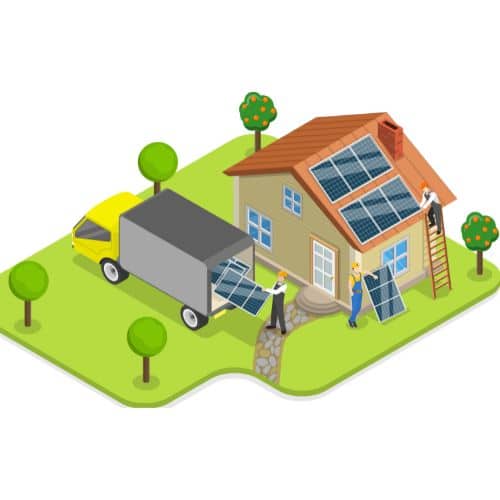.elementor-widget-text-editor.elementor-drop-cap-view-stacked .elementor-drop-cap{background-color:#69727d;color:#fff}.elementor-widget-text-editor.elementor-drop-cap-view-framed .elementor-drop-cap{color:#69727d;border:3px solid;background-color:transparent}.elementor-widget-text-editor:not(.elementor-drop-cap-view-default) .elementor-drop-cap{margin-top:8px}.elementor-widget-text-editor:not(.elementor-drop-cap-view-default) .elementor-drop-cap-letter{width:1em;height:1em}.elementor-widget-text-editor .elementor-drop-cap{float:left;text-align:center;line-height:1;font-size:50px}.elementor-widget-text-editor .elementor-drop-cap-letter{display:inline-block}
Harnessing the sun’s power is a brilliant way to reduce electricity bills, shrink carbon footprint, and become more energy-independent. With its abundant sunshine hours in Australia, solar power is particularly appealing for homes and businesses. This guide delves into solar panel installation, providing a roadmap for homeowners and business owners considering this sustainable upgrade.
Are you looking to save money on your electricity bills and reduce your carbon footprint? Solar energy is the perfect solution! Energy Matters can help you get up to 3 FREE solar quotes from pre-qualified and vetted solar firms in your area.
.elementor-heading-title{padding:0;margin:0;line-height:1}.elementor-widget-heading .elementor-heading-title[class*=elementor-size-]>a{color:inherit;font-size:inherit;line-height:inherit}.elementor-widget-heading .elementor-heading-title.elementor-size-small{font-size:15px}.elementor-widget-heading .elementor-heading-title.elementor-size-medium{font-size:19px}.elementor-widget-heading .elementor-heading-title.elementor-size-large{font-size:29px}.elementor-widget-heading .elementor-heading-title.elementor-size-xl{font-size:39px}.elementor-widget-heading .elementor-heading-title.elementor-size-xxl{font-size:59px}
Why install a solar panel system?
Before diving into the installation process, let’s explore why solar panels in Australia are a smart investment:
- Energy independence: Solar panels allow you to generate electricity, reducing grid reliance.
- Environmental impact: Solar energy is clean and renewable, with zero carbon emissions.
- Cost savings: Solar panels can significantly lower your electricity bills over time.
- Property value: A solar-powered home or business tends to have higher resale value.
Solar panel installation inclusions: Key components
When installing solar panels, you’ll need several key components:
- Solar panels (photovoltaic Modules): Photovoltaic (PV) panels capture sunlight and convert it into direct current (DC) electricity. Depending on your energy requirements, you can choose from custom configurations or pre-assembled panels that you can buy online.
- Solar inverter: This vital component transforms the DC electricity from your panels into usable alternating current (AC) that can power your appliances. Read more about Comparing String Inverters, Microinverters and Power Optimisers.
- Mounting system: This ensures your solar panels are securely fastened to your roof, considering factors like roof type and wind load.
- Monitoring system: Monitor your system’s performance with a system that tracks energy generation, battery storage levels, and overall system health.
- Solar battery (optional): This powerhouse stores excess solar energy generated during the day, allowing you to use it at night or during peak grid demand. Solar battery storage is optional but significantly boosts energy independence and savings potential.
- Additional inclusions: Depending on your chosen installer and plan, your solar panel installation might include cabling, DC and AC disconnect switches, grounding equipment, and permits/approvals.
Embrace the energy efficiency revolution by upgrading your solar systems and adding a battery or solar inverters with Energy Matters.
Planning your solar journey
Some crucial planning steps are essential before diving headfirst into solar panel installation.
Assess your energy needs
Start by understanding your current energy consumption. Analyse your electricity bills to determine your average monthly kilowatt-hour (kWh) usage. This will help size the solar system to meet your energy demands and ensure you generate enough power.
Explore your roof
The success of your solar panel installation hinges on your roof’s suitability. Factors like size, orientation (north-facing is ideal), shade obstructions, and roof type (tiled, metal) all play a role. Conduct a thorough roof inspection to identify any potential issues that require addressing before installation.
Research and compare
The Australian solar market is vibrant, with numerous installers offering their services. Get quotes from reputable companies and compare their system proposals, pricing structures, warranties, and experience. Look for companies accredited by the Solar Accreditation Australia (SAA) to ensure quality and adherence to safety regulations.
Financing options
Solar panel installation comes with an upfront cost. However, the long-term benefits outweigh the initial investment. Explore financing options like solar loans, rent-to-own plans, or government rebates to make the switch to solar more accessible.
Finding a reputable installer
Selecting a qualified and experienced solar installer is vital. Here are some tips:
- Get solar quotes: Obtain quotes from several SAA accredited installers. The SAA ensures installers meet the highest industry standards.
- Compare systems and warranties: Carefully compare the proposed solar systems, including panel types, inverter brands, and warranty coverage.
- Read reviews: Research online reviews and testimonials to gauge potential installers’ reputation and customer satisfaction.
The solar installation guide (how to install solar panels)
Once you’ve chosen a solar installer, the solar panel installation process typically unfolds in the following stages:
1. Site assessment
The installer will visit your property to assess your roof’s suitability, sun exposure, and potential shading issues. Read more about Site Assessments for Solar: What to Expect.
2. System design
The installer will design a customised solar system layout based on the site assessment and your energy needs.
3. Permitting and approvals
The installer will handle obtaining the necessary permits and approvals from local authorities.
4. System installation
- Qualified installers: Choose a SAA accredited solar retailer with a proven track record. They’ll handle the installation, adhering to safety regulations.
- Mounting structure: The type of mounting structure depends on your roof type and local wind and snow loads.
5. Solar panel installation
Panel placement: Installers will strategically position the panels for maximum sun exposure, ensuring optimal energy generation.
6. Electrical connection
- Inverter installation: The inverter converts the DC (direct current) electricity generated by the panels into AC (alternating current), which your home appliances use.
- Connection to the grid: A connection to your main electricity meter is established for grid-connected systems.
- Safety considerations: Safety is paramount. Qualified installers will ensure proper earthing and safety switches are implemented.
7. Connection and inspection
The system will be connected to your electrical grid and undergo a final inspection to ensure safety and compliance.
8. System monitoring and maintenance
- Monitoring system: Most solar systems come with monitoring systems, which allow you to track your energy production and identify potential issues.
- Regular maintenance: While minimal, occasional cleaning and system checks are recommended to maintain optimal performance.
Key considerations for home and business installations
While the core installation process remains similar for homes and businesses, some key differences exist.
For homes:
- Focus on self-consumption: Homeowners often prioritise maximising the amount of solar energy they can use, potentially reducing reliance on the grid. Battery storage can further enhance this goal.
- Aesthetics: Homeowners may prioritise integrating the solar panels seamlessly with their roof’s aesthetics.
- System size: Homes typically require smaller solar systems than businesses catering to residential electricity consumption.
Read more about:
-
- Preparing Your Home for Solar Panel Installation: A Checklist
- Finding the Perfect Fit: Solar System Sizing for a Single-Person Home
- Finding the Solar Sweet Spot: Choosing the Right Solar System Sizing for a Working Couple with an EV
- Finding the Right Fit: Solar System Sizing for an Aussie Family of 3 with an EV
- Powering Up Your Aussie Family of 5: A Guide to Solar System Sizing
- Choosing the Right Solar System Sizing for Retired Coupled Australians with EVs
For commercial and businesses:
- Larger systems: Businesses often have higher energy demands, requiring larger solar power systems.
- Focus on cost reduction: Businesses are primarily driven by reducing their electricity bills and overall operational costs through solar energy generation.
- Single-phase vs. three-phase power: Commercial buildings often use three-phase power, requiring a compatible inverter system. Read more about Comparison of Single-Phase and Three Phase Solar Inverters.
- Net metering vs. feed-in tariffs: Businesses may have different options for selling excess solar energy back to the grid.
- Commercial incentives: Businesses may be eligible for additional government commercial rebates and incentives for installing solar panels.
.elementor-widget-image{text-align:center}.elementor-widget-image a{display:inline-block}.elementor-widget-image a img[src$=”.svg”]{width:48px}.elementor-widget-image img{vertical-align:middle;display:inline-block}

Pro tip: Consult with your solar installer and a commercial energy advisor to tailor a solar solution that meets your business’s specific needs and integrates seamlessly with your existing electrical infrastructure.
Contact us today for up to 3 FREE quotations from commercial solar firms we’ve pre-qualified and vetted for their track record of delivering Australia’s best business solar systems.
Read more about commercial and business solar:
The benefits of going solar
Lorem ipsum dolor sit amet, consectetur adipiscing elit. Ut elit tellus, luctus nec ullamcorper mattis, pulvinar dapibus leo.
The benefits of making the switch to solar power are plentiful:
- Reduced electricity bills: Solar panels significantly reduce your reliance on the grid, leading to substantial savings on your electricity bills.
- Increased property value: Homes and businesses with solar panels tend to have a higher market value.
- Environmental benefits: Generating clean energy contributes to a lower carbon footprint and a more sustainable future.
- Government solar incentives: The Australian government offers various rebates and incentives to encourage solar panel installation, making it a more accessible option.
Finding the right solar incentives
The specific incentives you qualify for will depend on your location, system size, and property type. To find the most up-to-date information and applicable rebates, check our pages.
Going solar with confidence
Following these steps and conducting thorough research, you can embark on a smooth solar panel installation journey in Australia. Solar power is a significant investment that can significantly reduce electricity bills, minimise environmental impact, and contribute to a sustainable future. So, plunge and illuminate your Australian home or business with solar power!

Why choose Energy Matters?
- We’ve been in the solar industry since 2005 and have helped over 40,000 Australian households journey to energy independence.
- We’ve pre-qualified and vetted our solar installers, who are accredited for their track record of delivering Australia’s best business and household solar systems.
- We’ll match you with installers who are local to you so you can get a quote that’s tailored to your needs.
Benefits of going solar with Energy Matters

Get up to 3 FREE quotes
We’ll connect you with 3 different solar installers so you can compare prices and services.

Work with trusted installers
We only work with solar installers who have been pre-qualified and vetted for their track record of delivering quality solar systems.

Get peace of mind
We’ll support you from the initial consultation to the final installation. Our team will provide you with the information you need to go solar!
Questions? Contact our team of friendly experts for free, no-obligation advice on the best solar panels, best solar batteries and full systems for your circumstances. You can also generate a quick solar quote or view our current system specials.
Ready to go solar? Get an instant assessment
To find out how much a solar system with storage or even an EV charger will cost, try our easy-to-use solar power and battery storage calculator! It will generate performance data and possible cost savings.
We can forward your information to 3 trusted local installers in your area to obtain free, no-obligation solar quotes.
Find out how much you can expect to pay for solar
The form can be filled in the actual website url.
Ready to find out more? Get FREE quotes for solar, batteries + more
The form can be filled in the actual website url.
*Prices quoted are to be used as a guide only and do not factor in state and other rebates and incentives. Includes STC discount.
.elementor-column .elementor-spacer-inner{height:var(–spacer-size)}.e-con{–container-widget-width:100%}.e-con-inner>.elementor-widget-spacer,.e-con>.elementor-widget-spacer{width:var(–container-widget-width,var(–spacer-size));–align-self:var(–container-widget-align-self,initial);–flex-shrink:0}.e-con-inner>.elementor-widget-spacer>.elementor-widget-container,.e-con>.elementor-widget-spacer>.elementor-widget-container{height:100%;width:100%}.e-con-inner>.elementor-widget-spacer>.elementor-widget-container>.elementor-spacer,.e-con>.elementor-widget-spacer>.elementor-widget-container>.elementor-spacer{height:100%}.e-con-inner>.elementor-widget-spacer>.elementor-widget-container>.elementor-spacer>.elementor-spacer-inner,.e-con>.elementor-widget-spacer>.elementor-widget-container>.elementor-spacer>.elementor-spacer-inner{height:var(–container-widget-height,var(–spacer-size))}.e-con-inner>.elementor-widget-spacer.elementor-widget-empty,.e-con>.elementor-widget-spacer.elementor-widget-empty{position:relative;min-height:22px;min-width:22px}.e-con-inner>.elementor-widget-spacer.elementor-widget-empty .elementor-widget-empty-icon,.e-con>.elementor-widget-spacer.elementor-widget-empty .elementor-widget-empty-icon{position:absolute;top:0;bottom:0;left:0;right:0;margin:auto;padding:0;width:22px;height:22px}
Our Energy Matters CEO, Roshan Ramnarain, will feature stunning homes installed with the latest solar technology every Saturday at 5:00 p.m. on Open Homes Australia on the 9Life channel. Be sure to watch this show; you won’t want to miss it!

The post A Comprehensive Guide to Solar Panel Installation in Australia appeared first on Energy Matters.


















